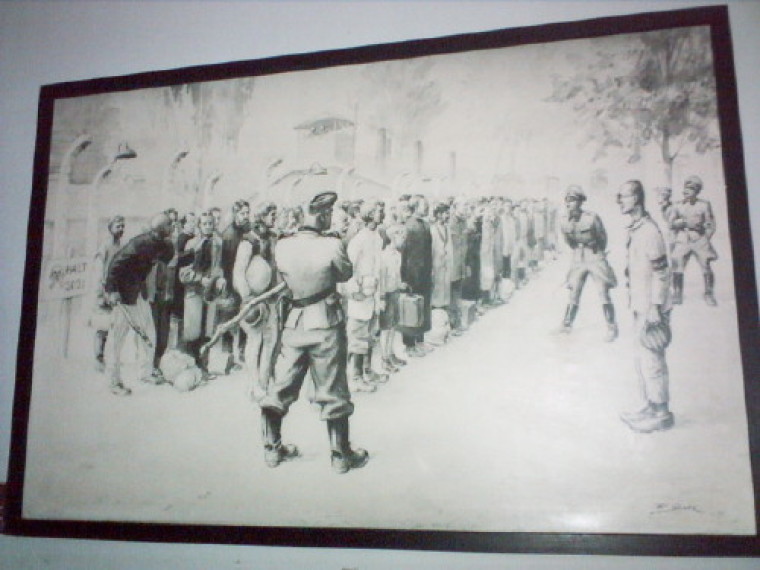
He had been invited to The March of the Living by Bridges for Peace, a Christian Mission based in Jerusalem, as part of a 48 person international Christian delegation which was there to stand beside and illustrate commitment to faith, hope and love of all faiths and all peoples. This is an annual event; a very slow walk from Auschwitz to Birkenau concentration camps – over 20,000 people not really knowing what they are doing and not in control of where they were going.
The then Israeli Prime Minister, Ariel Sharon, addressed the crowd, as well as the Chief Rabbi of Jerusalem, who emphasized the purpose of the 'March' as affirmation of life, rather than despondency over the past. He quoted a very powerful word from the Old Testament which fitted our days of reading of Jeremiah 30. The environment was electric. We stood in Birkenau in the ruins of prisoner buildings (the gas ovens were destroyed and made to look like bomb shelters) and a "voice" kept speaking the names of persons murdered at Auschwitz and their country of origin. (The whole old world eventually gets a mention).
If my maths was correct it would take 60 days to read the names of all those murdered only at Auschwitz (4 seconds x 1,300,000). As we filed into the Auschwitz2 / Birkenau site, the submachine guns and police and helicopters buzzing was surreal. The Israelis do very well with security, particularly with Prime Minister Sharon in attendance.
As Mark Tronson reflected on the proceedings, five years later, he again reaffirmed the surprising realization which answered a host of questions which he had not fully understood. He thought about the youth of our modern soldier-warriors. Corrie ten Boom, who wrote the famous book, The Hiding Place, of her years in a Nazi Concentration Camp observed that the SS Guards looked older than their 'real' teenage years in their spic and span black uniforms.
M V Tronson mused about the old photographs of our own WWI soldiers leaving home in their military uniforms and how mature they appeared - yet for the most part they were just lads as were these SS Guards. He also recalled his own much younger cousin going off to the first Gulf War in his Naval dress uniform, looking much older than his years.
The Israeli guide told us that most of the SS Guards at these death camps came out of the Hitler Youth movement, as part of the compulsory training of the 'military machine', and were in most cases in their early 20s – or younger.
"While I listened to these accounts of young soldiers, it dawned upon me that the Polish police and soldiers - who were everywhere about - also looked so young," remembered Mark Tronson.
And, like young people everywhere, they felt as though they were indestructible, even though they had not yet had the experience of life to think of others in less fortunate positions (empathy needs development). Added to this was their brainwashing, from their time in the Youth Movement, aimed at convincing them that they were a superior race and that the Jews were to be seen as vermin to be totally wiped out.
Little wonder there was a total disregard for human life, officially, although M V Tronson notes there are stories of guards who used their influence to save inmates or make their lives a little more bearable, at great risk to their own lives. Human nature will always produce morally upright people, even in the most dire circumstances.
The tour takes visitors along the road past factories where 'fit' Jewish men worked from the camp and along the railway line that leads into Birkenau. Between the two arms of the line, there is the railway platform where "selection" took place after the inmates were taken off the train cattle cages.
Josef Mengeler would supervise, and he moved a finger to left or right; and right was gas chamber. Almost all of the women and children went right (except for healthy-looking, single, younger women and teenagers who seemed 'fit' to work). Those to the right were told they were going to a communal shower, and they were usually dead within 30 minutes. The chambers killed up to 3,000 people each day.
"We walked through the living quarters for those who had to wait or those who worked," remembered M V Tronson. "There were 13 to a bed space and no heating as any fireplaces that did not work. The Allies found 835,000 women's dresses, 35,000 pairs of men's shoes, and 1,450 kg of female hair left at the site when they arrived. There were also thousands of empty cans which had contained cyclon B pellets (this was the cyanide that was used in the gas chambers towards the end - after some former experimental gases had been deemed less efficient).
It is remarkable being around the Holocaust survivors and their families that we met and chatted to, and to discover their pain.. The dust they were standing on was from cremated dead bodies - they said it was sacred ground.